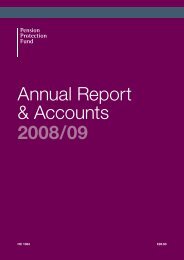Statement on Equalisation for GMPs AND the application of a ...
Statement on Equalisation for GMPs AND the application of a ...
Statement on Equalisation for GMPs AND the application of a ...
- No tags were found...
Create successful ePaper yourself
Turn your PDF publications into a flip-book with our unique Google optimized e-Paper software.
B.2 Equalisati<strong>on</strong> <strong>of</strong> accrual – Modified Method (2)Following a c<strong>on</strong>sultati<strong>on</strong> in April 2008 (where <strong>the</strong> PPF set out 4 possible methods <strong>of</strong>equalisati<strong>on</strong> <strong>for</strong> <strong>GMPs</strong>) <strong>the</strong> PPF approved “Method (2)” as being <strong>the</strong> most suitable method<strong>of</strong> equalisati<strong>on</strong> <strong>for</strong> <strong>GMPs</strong> <strong>for</strong> <strong>the</strong> PPF.“Method (2)” requires a comparis<strong>on</strong> <strong>of</strong> <strong>the</strong> total pensi<strong>on</strong> that would be payable in respect<strong>of</strong> service periods between 17 May 1990 and 6 April 1997 in respect <strong>of</strong> two individualswho are equal in every respect except <strong>on</strong>e is a male and <strong>the</strong> o<strong>the</strong>r is a female member.The comparis<strong>on</strong> should be made when <strong>the</strong> pensi<strong>on</strong> comes into payment, and annually (ormore frequently) <strong>on</strong>ce that pensi<strong>on</strong> is in payment. The higher pensi<strong>on</strong> amount is <strong>the</strong>npaid.Modified Method (2) is a partial applicati<strong>on</strong> <strong>of</strong> method (2). It is similar to method (2)but allows <strong>for</strong> <strong>the</strong> special circumstances applicable to <strong>the</strong> PPF; namely that PPFcompensati<strong>on</strong> treats all pensi<strong>on</strong>s after <strong>the</strong> Assessment Date in <strong>the</strong> same way and does notdifferentiate between GMP and excess pensi<strong>on</strong>. The PPF approved this method as being<strong>the</strong> most suitable <strong>for</strong> PPF compensati<strong>on</strong> payments following <strong>the</strong> 2008 c<strong>on</strong>sultati<strong>on</strong>.The PPF is <strong>the</strong>re<strong>for</strong>e in <strong>the</strong> <strong>for</strong>tunate positi<strong>on</strong> that equalisati<strong>on</strong> <strong>for</strong> GMP when calculatingPPF Compensati<strong>on</strong> <strong>on</strong>ly needs to be carried out at a single date - <strong>the</strong> Relevant Time(<strong>the</strong> day be<strong>for</strong>e <strong>the</strong> Assessment Date).Changes to <strong>the</strong> calculati<strong>on</strong> <strong>of</strong> PPF compensati<strong>on</strong> after <strong>the</strong> Relevant Time in accordancewith this Modified Method (2) should be applied as <strong>the</strong> first step. The PPF has establishedc<strong>on</strong>versi<strong>on</strong> factors (see secti<strong>on</strong> D.1) to calculate opposite sex GMP which can be used toapply Modified Method (2). Alternatively NISPI has a Dual GMP calculati<strong>on</strong> service.However, this <strong>on</strong>ly deals with <strong>the</strong> inequality in <strong>the</strong> accrual rates <strong>of</strong> GMP. In particular itdoes not recognise <strong>the</strong> right <strong>of</strong> a female to receive GMP at age 60.The next secti<strong>on</strong>s (B.3-B.5) look at <strong>the</strong> o<strong>the</strong>r statutory obligati<strong>on</strong>s <strong>for</strong> schemes that werec<strong>on</strong>tracted-out by providing <strong>GMPs</strong>.14



